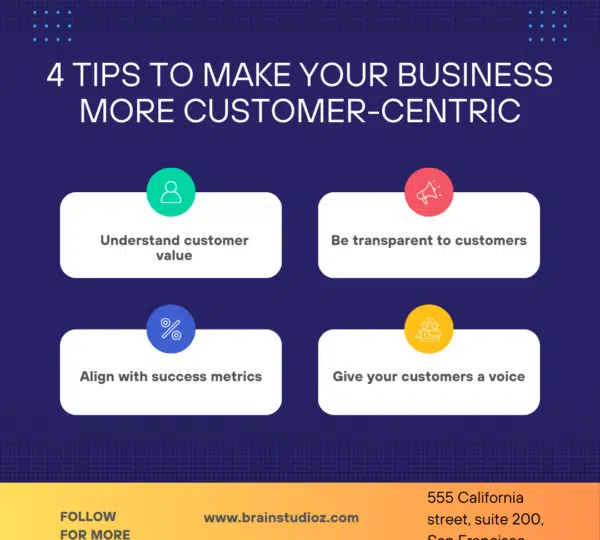
September 22, 2024
/
Build Customer-Centric B2B Culture for Lasting Success
By positioning the customer at the center of every business decision, a business can significantly increase customer satisfaction and loyalty, ultimately driving company success. At Brain Studioz, we have effectively built a customer-centric B2B approach, and we’re here to share how you can do the same.
Those businesses that are Build Customer-Centric B2B really make the difference in differentiating them from the competition and enhancing their reputation for contributing to a stronger and more loyal customer base.
In fact, all that we do-from the products we develop to marketing strategy and everyday operations-goes back to providing value to our customers.
This customer-centric mindset makes it possible for us to offer quality services while increasing the relationship with the clients, thereby enhancing client satisfaction.
It's been the buzzword for several years, but this is real; by putting customers at the core of every business decision, we can understand the customer's pain points, can hear feedback, and address them throughout our organization.
For the last ten years, I was building a Build Customer-Centric B2B culture in Brain Studioz. Here are my tips to business leaders who aspire to do the same.
 However, most importantly, helping clients meet their goals is what will make them become repeat customers and clients. Those with a customer-facing role will be expected to work with clients in establishing what will best work for their business.
That constitutes a huge part of determining what the clients' goals are and then identifying how they will measure success. The better companies understand the rationale behind each client's desires, the better the companies will know what it takes to deliver results that will satisfy customers.
This helps businesses achieve client expectations, also establishing a co-operative relationship. Identifying success metrics that they can work toward together helps make the service providers and their clients a team. Therefore, many clients may relate their relationship to being a partnership instead of a traditional client-vendor relationship.
Collaboration encourages open communication, trust, and respect and, thus, creates more satisfaction and loyalty in the long term. Moreover, it ensures a common goal for further development and innovation due to both parties' involvement in attaining mutual goals and, therefore, are likely to try and take calculated risks.
Beyond that, meeting the unique needs of the different customers will make all the difference between the market leaders and followers. That is what drives sustainable long-term growth of a successful company and builds up their loyal customer base.
However, most importantly, helping clients meet their goals is what will make them become repeat customers and clients. Those with a customer-facing role will be expected to work with clients in establishing what will best work for their business.
That constitutes a huge part of determining what the clients' goals are and then identifying how they will measure success. The better companies understand the rationale behind each client's desires, the better the companies will know what it takes to deliver results that will satisfy customers.
This helps businesses achieve client expectations, also establishing a co-operative relationship. Identifying success metrics that they can work toward together helps make the service providers and their clients a team. Therefore, many clients may relate their relationship to being a partnership instead of a traditional client-vendor relationship.
Collaboration encourages open communication, trust, and respect and, thus, creates more satisfaction and loyalty in the long term. Moreover, it ensures a common goal for further development and innovation due to both parties' involvement in attaining mutual goals and, therefore, are likely to try and take calculated risks.
Beyond that, meeting the unique needs of the different customers will make all the difference between the market leaders and followers. That is what drives sustainable long-term growth of a successful company and builds up their loyal customer base.
4 Tips to Make Your Business More Build Customer-Centric B2B

4 Tips to Make Your Business More Build Customer-Centric B2B
- Give value
- Be transparent to customers
- Align with success metrics
- Give your customers a voice
Understand customer value:
Here at Brain Studioz, we have always said that "It's easy to build a good business when you're delivering a good product," meaning that the value you give customers is your greatest point of sale. By delivering real value to customers in terms of excellent products and services, businesses establish reputation and set the foundation for customer loyalty and repeat business. It is not that hard for sales teams to get caught up on making the sale, but high satisfaction of the customer comes from ensuring that the customers get what they want. In this manner, a post-purchase experience can be made compatible with the advantages of a product or service that satisfies the needs of customers and meets their expectations. May it be a good website, a high ROI on the latest campaign, or a new product - it is this continued satisfaction that would make customers keep coming back to the brand, thus building further loyalty that may even turn into brand advocacy. Mature companies understand that building long-term customer relationships is based on delivering consistent and measurable value to their customers.Transparency for building customer relationships:
Any Build Customer-Centric B2B has, at its core, a relationship with every client. The best way companies can develop better relationships with customers is by transparently being candid and open about what is happening from the initial days of their partnership. For instance, making them aware of new products and helping them identify what solutions will be best for their business will make a potential client confident to buy. If they are interested in one product but another will have a much greater impact, the customer-centric business will help identify a solution that will effectively assist them in achieving their goals. Companies that want to establish long-run partnerships with such clients in delivering the best service about what a customer requires.
When customers believe a company is transparent, they perceive it as having their best interests at heart. This perception strengthens customer loyalty, as they are more likely to do business with companies they trust.




